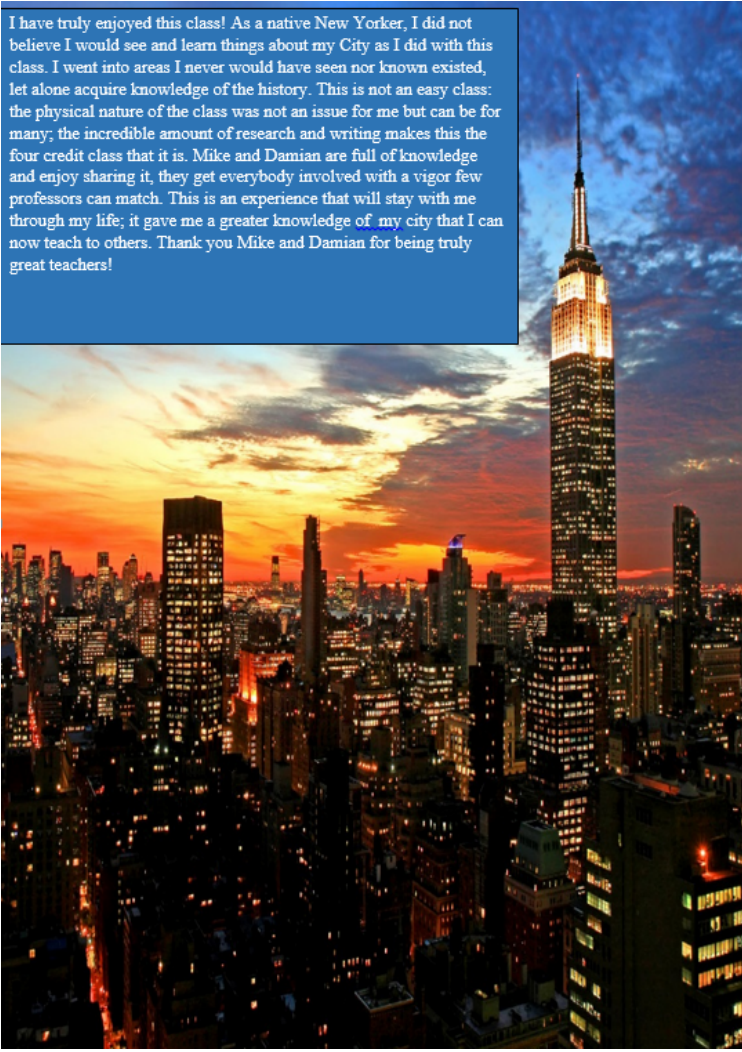
Today, on our last day of the Gotham Experience: we began our day from our usual check point at Penn Station and headed downtown on the Sixth avenue line F train to Delancey Street. We exited the subway on Delancey and Essex with the Williamsburg Bridge in the backdrop, this bridge was at one time known as the Jews Highway. The Williamsburg Bridge got that name due to the heavily populated Jewish community and the poor living conditions the lower East Side offered. When the bridge was built, the Jewish community did not hesitate to cross over to Brooklyn and back again for services in the city.
Upon exiting the subway we immediately hopped into the Essex Street Market for a quick bite to eat; this was going to be a long day prior to lunch. In the early 1900s the lower East Side was the most densely populated area in the entire world, one really has to think about this. The Lower East Side is a small area, to house that many people would have caused many problems including housing, jobs and infection, just to name a few. Where did the bodily excretions go? Where did the horse manure and the garbage go? There was no running water, outhouses were not plentiful and sewers did not exist. The only place for the excrement and garbage to go was in the street: the amount of people walking in this mess creates a scene in my mind that causes me to be grateful I did not share this experience. The 1900s had many street vendors selling many different items such as meat, fruit and vegetables, pots and pans etcetera. The vendors went from 25 to 25,000 causing increased traffic problems; this included the police and fire department being unable to pass through the throngs of people. Mayor LaGuardia felt the best solution was to build an area for the vendors, thus allowing the flow of traffic to improve. This new area became known as the Essex Street Market. The market was renovated in the late 1990s-early 2000s and the products changed according to the community’s needs. We passed the Bailey Stoker Synagogue on our way to the Henry Street Settlement and learned that Bailey Stoker was an area in the north east section near the Russian Polish Border. We also passed Saint Mary’s Church, according to our guide Jim; this is the third oldest church in the city. The Henry Street Settlement was created by Jane Adams and settled by Lillian Wald. Lillian Wald gained financial backing from Jacob Schiff, which was purchased from Alexander Hamilton Jr. Lillian Wald used the home to train nurses: she had a staff of ninety trained nurses sent to the tenement houses to treat the ill. Eventually this nursing service became known as the Visiting Nurses Service (VNS) as we know it today. We proceeded toward Chinatown and Little Italy, passing the Forward Building which was the site the Jewish Newspaper” Forward”. The building has four radicals carved into the face: Carl Marx, Frederick Engle’s, Leidnect and Fredrick Salk. The building is now a luxury cooperative and condominium complex: 139 East Broadway between Rutgers and East Broadway is a terra cotta with Jewish stars engraved into it. It is here that one can almost envision what life must have been like in the 1900s, when the area was the most densely populated area in the world. During the 1900s the lower East Side was the most densely populated area in the world; it was home to the Second and Third Avenue El. There were Trolleys then, and the roads were narrower than they are today: there were no sewage plants piping for waste. In addition, horse manure littered the street and garbage piled up. The Manhattan Bridge seems to be the line where Chinatown begins, the architect who designed the New York Public Library also designed the arch entering the Manhattan Bridge. In 1870 the Chinese population was at 200 people, in 1882 the population reached 2000 people. In 1900 the Chinese Exclusion Act went into law and no other Chinese where allowed into the Americas. At that time, those already here were allowed to stay and out of the 7000 Chinese here only 200 were women. In 1942 Franklin Delano Roosevelt rescinded the act. There was much prejudice against the Chinese people, to protect them physically and financially the Tong Association was formed. This association allowed the Chinese people to live in peace. Little Italy was built on top of Five Points; this is the area the Irish were living in at one time. The population totaled 10,000 people then, today it is home to 5,000 people and the area is extremely congested. I was looking forward to going to Ferraro’s for a canola but the day was too filled to enable that treat. The Amazing Race began at 1:45, I was in group C. Our first stop was to be the Central Park Zoo which opened in 1935. The zoo was designed by Olmstead and Vaux who disapproved of caging animals, yet when they began the park’s construction, live animals began arriving to the park (Blue Guide p. 285-286). Our second stop was Delacort Musical Animal Clock, this clock chimes on the half hour and animals circle the tower while a nursery rhyme plays every hour. We then proceeded to the boat pond which can provide a nice relaxing day with Bethesda Terrace and Fountain as the forward drop to the Central Park Lake. Jeffery Wrey Mould, according to the Blue Guide (p. 289) was the artist used in the stone carvings here and in many parts of the park. He additionally designed many houses and churches as well. Mould, a sculptor was a musician also who played the piano and composed songs. From Bethesda Terrace we raced to Strawberry Fields, a tribute to the late and great John Lennon who was assassinated in the courtyard of the Dakota apartments in 1980. The main tribute site is IMAGINE which is inscribed in colorful tile. The Blue Guide teaches on page 292 that the area was originally intended for Bing Crosby. The area is now known as the Peace Garden and is one of the most visited areas in the city. Our last destination was the place where John Lennon was shot. The Dakota Courtyard is watched over by security. If one is not either staying there or a guest, one cannot enter, so we took a picture and left to meet our group for lunch. After a very nice late lunch at the Congee Village Restaurant, we walked over to the tenement museum and participated in the “Meet Victoria” tour. The tour was very informative, we spoke about the plight the new immigrants faced when coming to the Promised Land. The immigrant’s usual ship ride was approximately three weeks long, for those weeks they lived in the ships bilge. The people, while in an already crowded area with limited access to food, shared the bilge with cows and pigs without an opportunity to bathe or brush their teeth. Once reaching Ellis Island and reaching the front they were subjected to line inspections: this included visual and button hook checks for Trachoma, the inspections took about five hours. Once passing inspection the people took the short ferry ride to Manhattan, they now needed to find a job and a place to live. These people were often met by a person that would take them to a settlement house that they managed. In the Living Museum, our tour guide Daryl pointed out the pressed sheet metal on the ceilings and the burlap on the walls. The metal was used to contain fires while the burlap on the wall was a design in 1905. Daryl played the role of the man who ran the settlement house on 97 Orchard Street who claimed the apartment on the fourth floor was empty; it is here where we meet Victoria. Victoria Confino’s actor portrays a real person who lived in the tenement homes in 1910. She has been coached by the family, photographs and report cards which are some of the primary sources used to supply information to the public. The family consists of Spanish Sephardic Jews and speaks Ladino. In these times there were many Russian Jews who speak Yiddish; the Russian Jews frowned upon the Spanish Jews with many not willing to sell kosher products to them. Victoria explained what it was like living in a tenement in the early 1900s.It is not so surprising that once Victoria was able to speak enough English, she was told it was better for her to work and stay home to help clean and care for her brothers and sister. She was also advised that her brothers would be better off in school than her. It is known that up until the 1980s-1990s most women stayed home caring for the children, cleaning and cooking, while the husband was the sole provider of the household. In the tenement home the average number of people in the small three room apartment was ten; the people slept toe to nose because feet smelled better then bad breath. She asked us if we had ever had soda and explained that she drank it with a stick. Victoria at 14 years old worked four ten hour days at work and three days at home cleaning and caring for her siblings. The apartment’s rent were twenty dollars a month for the first floor and sixteen dollars a month for the fourth floor. The apartment did not come with a stove, the family needed to purchase one and they cost twenty-two dollars and fifty cents. Coal was supplied via a subscription and the boys had to collect it from the family’s bin and bring it to the home. Victoria became very excited when we asked about her favorite place which was the Grand Palace Dance Hall; there she would dance the Fox Trot, the Waltz and other dance steps. On a final note, Victoria explained that the boys used the chico liquo, this is an old term for peeing in a pot that she was responsible to clean. The Living Museum forces one to step back in time to a place that may have been simpler in some ways but was more difficult in many ways too. It gives one a “real feel” of stepping back in time. LOWER MANHATTAN AND CAPTIVATING CHELSEA On July 26, 2013 we traveled through lower Manhattan, we passed the Woolworth Building, which is celebrating its 100th anniversary this year, on our way to meet our tour guide Deidre La Porte at City Hall. I had never been to City Hall, but immediately upon seeing this magnificent building I was able to recognize it as a federal style building. The grounds are massive and afford one the view of the Brooklyn Bridge which I recently crossed over and the Woolworth building standing in all its magnificence. I could feel how one may envision their power by merely walking through the grounds. 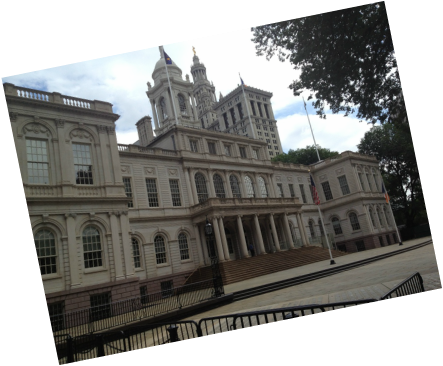   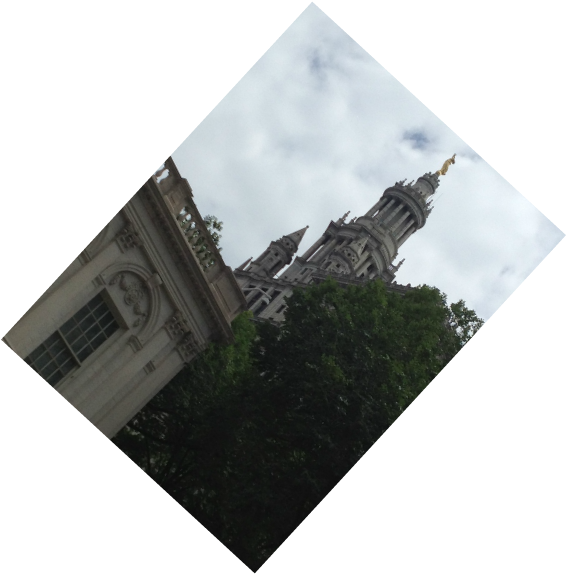 City Hall was originally called Town Hall, built at 73 Pearl Street where Federal Hall stands today. That is the location of the second Town Hall and George Washington’s inauguration. Upon entering City Hall for the first time, the authority the building projects is immediately felt. Thomas Jefferson, detested cities and following George Washington’s inauguration petitioned to move the capital to Pennsylvania. Eventually, New York State’s capital was relocated to Albany. The city was growing rapidly with immigration: in 1790 the census reported 31,000 people in the area. By 1800, there were 61,000 people and in 1810, 90,000 people were reported by the United States Census as living in the city. City Hall as it is known today was built from 1803-1815/16. The architects were chosen by the results of a competition with a prize of $350.00 (Blue Guide, p.84). The winners were Joseph Francois Mangin, a French immigrant and John McComb Jr., a native to New York. Winning this was considered to be quite an honor. Mangin’s name was somehow erased and McComb received credit for the design for many years until it was realized that Mangin’s name was missing. In 1812, before the completion of the building, people began to take residence in City Hall. The building housed the Mayor, City Watch and Common Council, courts, prisons and wine cellars. Eventually the prisons where relocated due to increased population. The caretaker’s cottage was built the same time as City Hall for one to watch for fires, as electricity was not installed until 1899. On the very top of the building there is a statue without a blindfold representing justice. The statue was built using sheet metal and painted to look like stone: just as the Statue of Liberty was built of sheet metal and left to turn to green. Originally, the statue was carved of wood. City Hall was built here on these grounds because this is where the population was concentrated. The building’s front was marble and the back was sandstone. The material was replaced in 1954 with limestone and granite; this was the first time City Hall had four matching sides. When first entering City Hall, brilliant Roman arches immediately attract the eye. Next you are attracted to the chandelier, which offers a touch of naturalistic nature. Inside, the building portrays the original marble and is seen as a duel floating staircase. There is a dome in the center that is entirely encased within the building. The dome cannot be seen from the outside as it encases the entire three floors from the inside. The walk up the floating staircase, which is attached to the ceiling to the Governor’s room, gives one a sense of entitlement. The Governor’s room houses the most important and notable portraits you can find gracing the walls. Notably, you will observe: George Washington 1732-1799; John Jay 1795-1801, Daniel Thompkins 1774-1828, Morgan Lewis 1754-1844 and George Clinton 1739-1812. George Washington’s original desk can also be seen here. 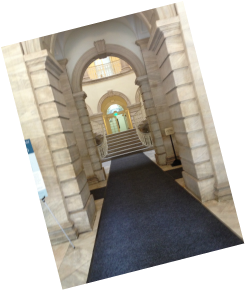    Notice the flowery natural pattern Notice the flowery natural pattern 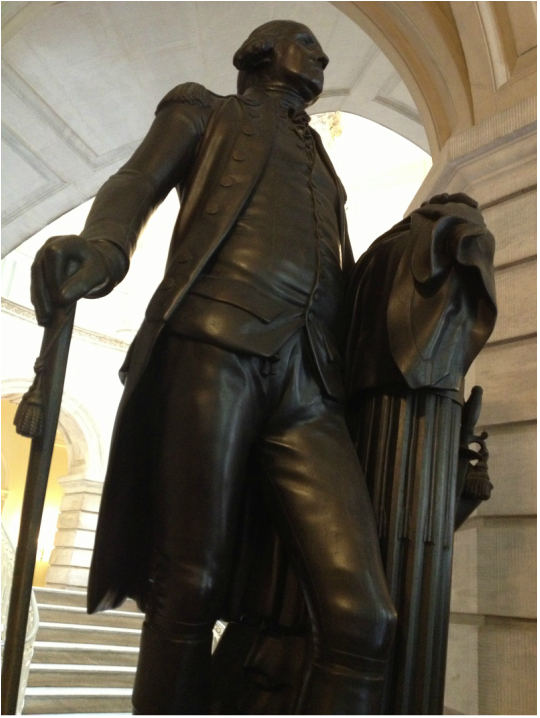 George Washington : life size George Washington : life size 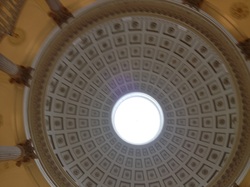 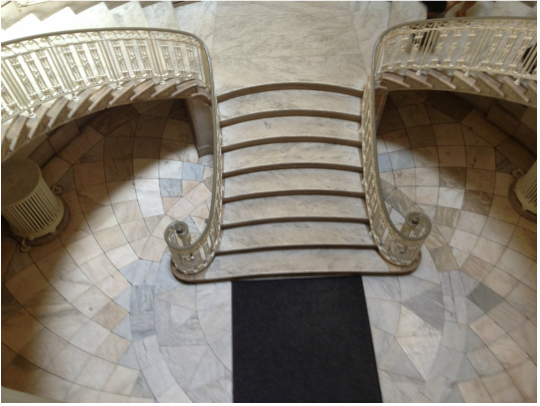 City Hall Chamber runs adjacent to the governor’s room, at one time this massive room was home to two different courts. John Dunkin was the architect commissioned for this change over in 1897. The mural on the ceiling, an allegorical painting (expression of meanings and generalization about human existence) is known as New York the Eastern Gateway. The corners of the ceiling have the city seal engraved into them and famous sayings. One of the corners quotes Abraham Lincoln, “A government of the people by the people and for the people”. The Chamber offers seats to the congressmen of each borough: 16 seats to Brooklyn, 14 to Manhattan, 10 to the Bronx, 8 to Queens and 3 to Staten Island. 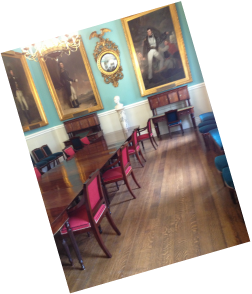 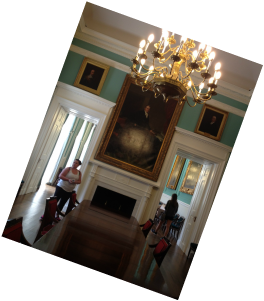  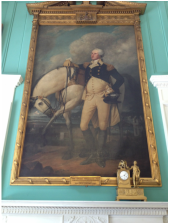     Time moves quickly in the New York Gothic Experience class, we left City Hall’s quiet powerful environment and returned to the hustle and bustle of city life. Passing through St. Paul’s Chapel, where President George Washington attended services and the 9/11 rescuers found refuge: our next stop would be Freedom Towers. The Freedom Towers are the direct result of the September 11, 2001 terrorist attack. This is a memorial site for both the 2,983 men and woman who perished on that dreadful day as well as the lives lost on the February, 26 1993 terrorist attack in the North Tower, where a truck bomb killed six people and injured in excess of 1000 people. The Twin Towers, also known as the World Trade Center was made up of seven buildings, an underground mall and a plaza. On February 26th Islamists planted explosives in the garage and on September 11th Islamists flew two planes, one into each tower destroying the entire complex and killing thousands. The towers were greater than 1300 feet tall, both had 110 floors. The towers would attract thousands of visitors and commuters to its site each day: the complex was so large it even had its own zip code, 10048. Before the attack on 9/11, eight postal workers were assigned to the towers alone. After the attacks over 80,000 pieces of mail continued to arrive at the address and were processed at the James A. Farley General Post Office, located across from Penn Station. The Post Office separated and held the mail or forwarded it without charge for three years. Normally, mail is only held for one year. Today approximately 300 pieces of mail arrive at the address daily; this is mostly bulk mail from senders who have not yet updated their lists. The 9/11 Memorial opened on the tenth anniversary of the attacks. It includes a North pool and a South pool, respectively named for the North Tower and South Tower. The pools are the exact footprint of the buildings, meaning this is the exact spot where the towers stood. The pool consists of a thirty foot drop of cascading water into a void where there is no end. The names of the dead are engraved in the continuous bronze railing that runs around the pool, giving loved ones an open area to grieve. The names are placed in a meaningful reflection of relationships they shared with others on that fateful day and are also placed according to the family’s requests. The park is surrounded by eleven foot oak trees and one Pear Tree. The pear tree was originally planted at the World Trade Center’s plaza in the 1970s and was found amongst the rubble of the 9/11 attack. The tree was nursed back to health and planted at the World Trade Center site in 2010. The tree represents survival, promotes strength and healing and helps us move forward with our lives.  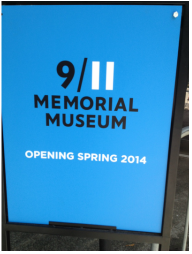 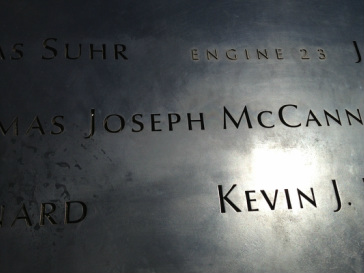 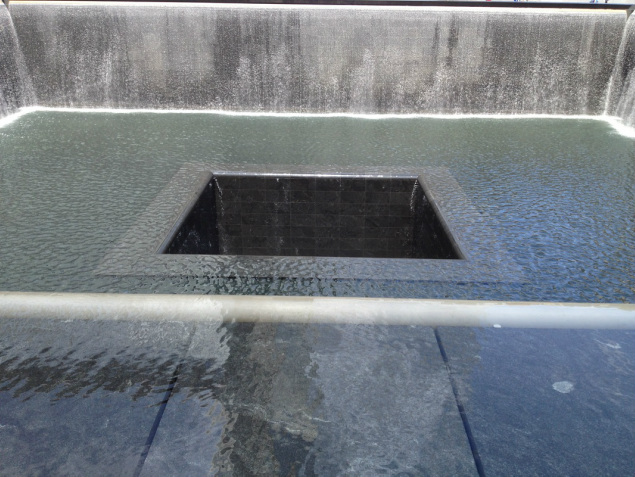 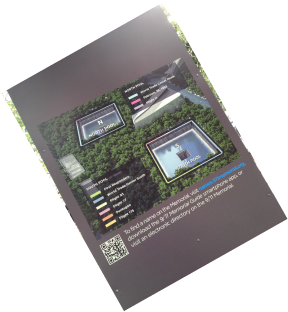 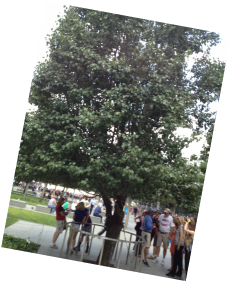 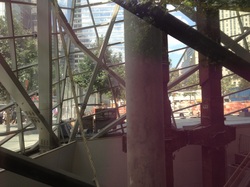 Inside look at museum to open in 2014 Inside look at museum to open in 2014 We left the 9/11 Memorial and started making our way towards Chelsea. While passing through Wall Street, we stopped at Federal Hall. This is, as mentioned earlier the site of the city’s first Town Hall and the place where George Washington was sworn into office. Federal Hall served as the nation’s first capital, eventually moving to Washington DC, it is also the site where the United State’s Bill of Rights was first introduced to congress. John Peter Zenger’s memory lives on in Federal Hall, portraying freedom of the press. John Zenger wrote the New Weekly Journal and voiced his criticism of Governor William Cosby. Cosby had Zenger arrested and Andrew Hamilton defended him. The jury failed to find Zenger guilty, in 1735 the Attorney General charged Zenger with libel. Today, the machinery used to roll out the news in Zenger's day, remains in Federal Hall. We continued on, passing Battery Park, a usually beautiful park is currently under construction and now closed to visitors. We walked up to Ninth Avenue and Hudson into the heart of Chelsea, also known as the meat packing district. The Blue Guide (p.185) states that Chelsea runs from the Hudson River to Sixth Avenue and West 14th – to the West 20’s, I thought Chelsea ran from Hudson to Eighth Avenue and from West 14th- West 25th Street. Chelsea received its name from a retired British soldier named Thomas Clarke. Clarke bought the land, naming it after a hospital in London being used for injured soldiers. Clarke’s grandson, Clement Clark Moore turned the land into residential housing. Clement was a classics professor, he published books ranging from agriculture to history. He is most famous for his poem “A Visit from Saint Nicholas” (Blue Guide, p. 185). The Hudson River Railroad was built in the mid 1800s bringing immigrants to the area as well as slaughterhouses and breweries. During the 1970s – 1990s Chelsea was home to transvestites, drugs, prostitution, and sex shops; Chelsea has undergone much transformation since the 1980s. The Ninth Avenue El, known as the High Line, rolled out its last train in 1980. In 1999, Friends of the High Line who had successfully defended its demolition opened the first park starting at Gansevoort Street to West Twentieth Street. The High Line, which now reaches to West 34th Street, is a comfortable stroll with the city below offering plenty of relaxing places to sit, eat, shop and watch street theater. 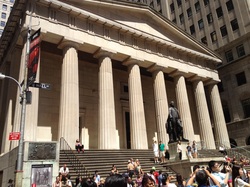 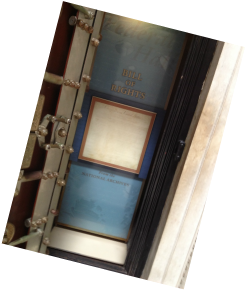   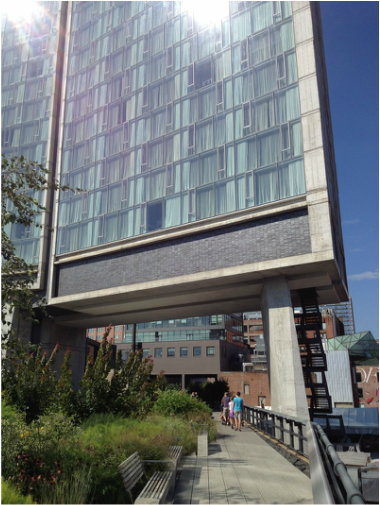 Standard Hotel: The beginning of the High LIne Standard Hotel: The beginning of the High LIne 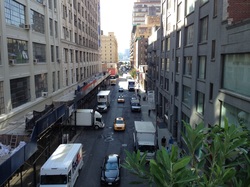 Chelsea is home to over 200 art galleries, we were able to get into a few of them. The first few galleries we entered were not of my taste, when we walked into Bruce Wolkowitz gallery things changed. The gallery is hosting a series of prints named Wrinkles of the City, Havana Cuba, the pieces are photographs of the faces of the elderly and their portraits posted on buildings. The piece that drew me to it was created by Alicia Adela Hernandez Fernandez 2012: it is a color print on metallic paper mounted on aluminum. The print shows a graffiti artist painting on a building wall with a face emerging from the brick with a passerby enthralled by it. Andrea Rosen Gallery located at 525 West 24th Street is presenting Simon Fujiwara's first solo appearance in New York. The Andrea Rosen Gallery describes Fujiwara's pieces as an explanation of identity and sexuality blending fact and fiction into works of art that demand conversation. 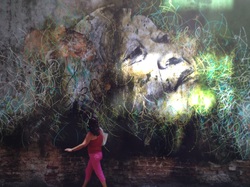 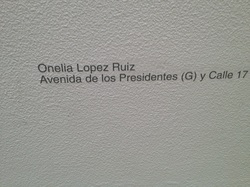 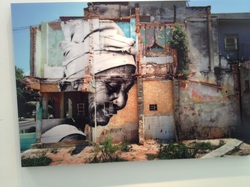 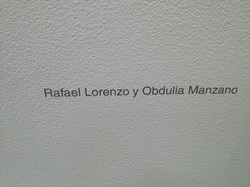  The piece being presented by the gallery is called Studio Pieta (King Kong Komplex). It debuted in March at Sharjah Biennial and now is being presented in New York. Fujiwara's original idea was to recreate a picture of his mother with her Lebanese boyfriend. Fujiwara was envious of his mother and felt an attraction to his mother’s boyfriend. The picture, upon initial view is that of a woman in a bikini and upon further inspection, the photo recreated is that of a man in a bikini holding his arms forward as if holding somebody. The second recreation shows the bikini clad man carrying another man in a trapeze under the back and knees. The third recreation shows the man in the trapeze alone. I believe Fujiwara's pieces reflect an issue in his life ready to be confronted, Fugiwara is depicting how much he and his mother look alike, his jealousy that he is not a woman, and his attraction to men. This is a piece that pops out and forces conversation due to its controversial topic and its presentation.  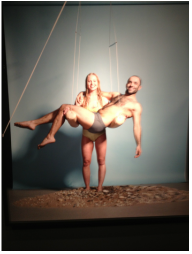  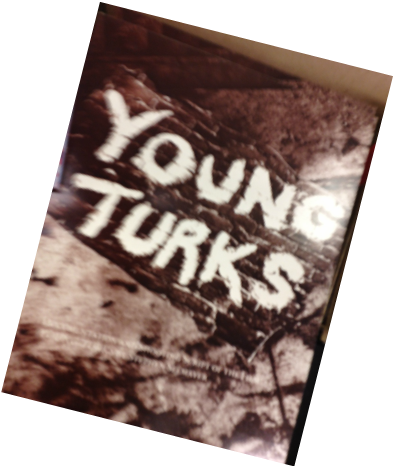 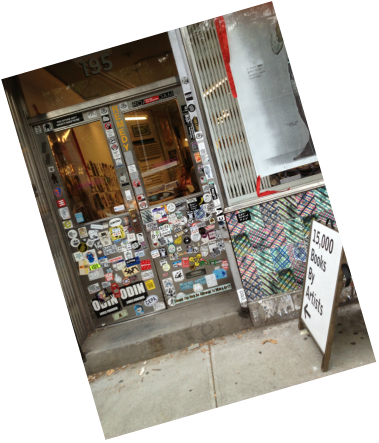 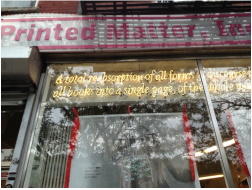
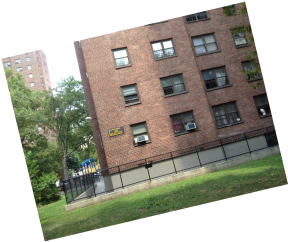  THE UPPER EAST SIDE Today we traveled to East Harlem, visiting the Museum of New York, The Bario, Central Park and The MMoA (Museum of Modern Art). The weather given to us on this day was a cool 97* with a heat index of 109*. The Museum of New York and The Bario were large Buildings taking up much space, the programs and activities provided by these museums have had a major impact on the positive neighborhood changes that have transpired. Beginning first with the Museum of New York, the Blue Guide (p. 376) prepared me for the twenty-two minute movie of New York City’s history of growth and change. East Harlem, part Genovese crime family and part Hispanic was where we bagan. The museum of New York shows a new housing trend, claiming, New York City is the home of the wealthy, white, young female. Those that choose to be in this loop and cannot afford it are migrating to the outskirts of the city; ie: Brooklyn, East Harlem, Long Island City ect; people want to live in or close to the city. East Harlem has a large amount of housing projects; the projects were built to supply the poor with a place to live. Unfortunately, the projects breed drugs and violence there is a push to culturally combine neighborhoods and provide micro – housing in the near future. 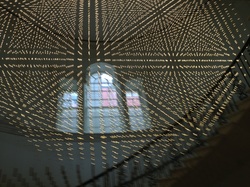 The Museum of New York, spoke of the changing landscape of New York City, foreseeing the driving force as females, uninterested in marriage. The new image is youth living on the outskirts, gentrifying neighborhoods and living in tiny living spaces of 325 feet: this is called micro housing. Micro-housing can be a temporary transition for the young and a good permanent transition for the elderly. While at the Museum a twenty two minute movie showed the beginning of NYC beginning with the City of Strangers 1825-1865 and ending with the Twenty-First Century City: this was nice as the film brought our experienced together.   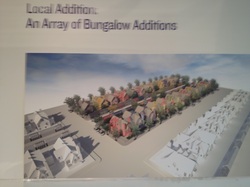 The Museo De Bario (Museum of the neighborhood) is a neighborhood museum that inspires of neighborhood artists. Maryellen, our tour guide, brought us through a small part of East Harlem. Maryellen, brought us to the mural created by Hank Prussing. Prussing’s, Spirit of East Harlem, finished in 1973, depicts neighborhood residents participating in various activities outside of the home. Manny Dega, a respected artist today, was unknown at the time of Hank Prussing’s Spirit of East Harlem apprenticed with Prussing and thus, helped to create the piece, immortalizing the people of the neighborhood on the buildings bricks. In regards to Manny Vegas work our tour guide, Maryellen explained, Vega places an arrow on his pieces commemorating his late wife. Different literature discusses Vega leaving a crab, his wife’s horoscope sign, to commemorate her. 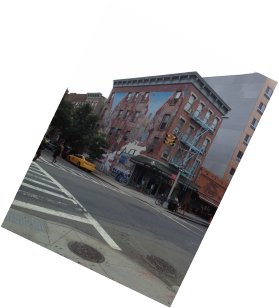 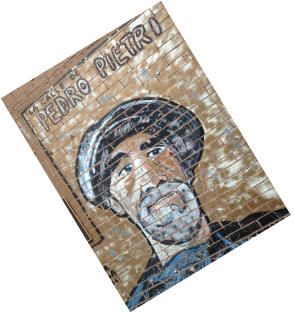 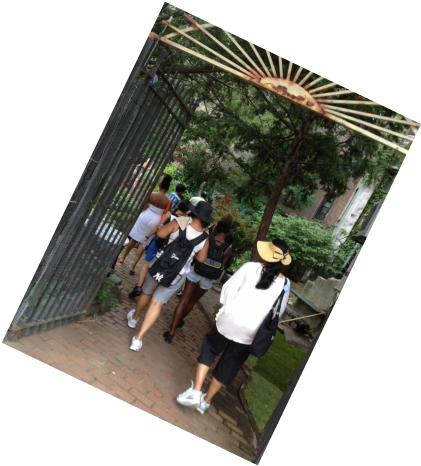 Our tour guide brought us to the Modesto “tin” Flores, this is a garden that honors women. Upon entering the area the city becomes quiet; the sound of a brook with a child’s play alligator are the first encounter. The garden presents a small arched bridge and a sculpture that represents a woman’s fallopian tubes. The gardens highlight is the painting by Yasmin Hernandez and the common link the women in the painting and the artist had in common: all three women suffered a miscarriage. 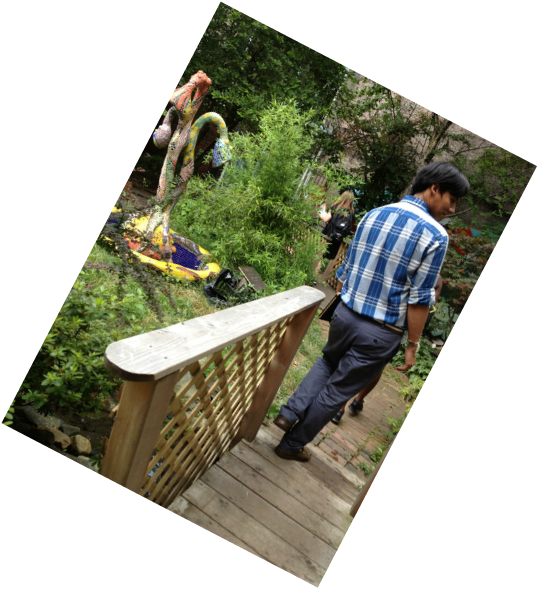   Fallopian Tubes Fallopian Tubes From here we proceeded to the Graffiti Hall of Fame, a legal place for the graffiti artist to paint. The wall is part of the Jackie Robinson High School. Then on to Don Jorge and his Botanic Ajista. Mister Jorge, a colorful man taught of his long history in East Harlem and the use of old fashioned medicine using herbs and sprinkled with faith and hope. Don Jorge also explained that candles represent saints, and Saint Anthony is the keeper of the gate and opens the twenty one paths. This is a Dominican voodoo religion and Don Jorge is as I see it is a Houngan; a male Voodoo Priest.  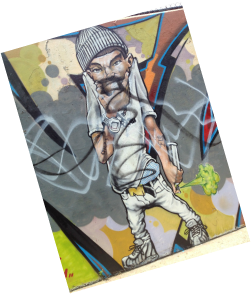 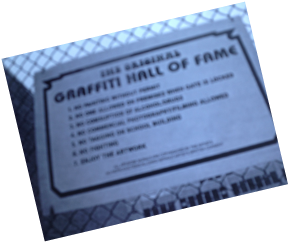 Graffiti Rules Graffiti Rules 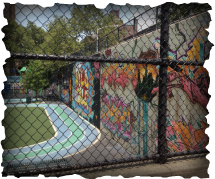 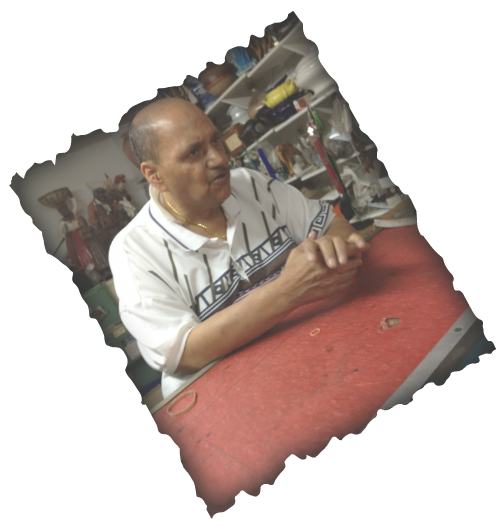 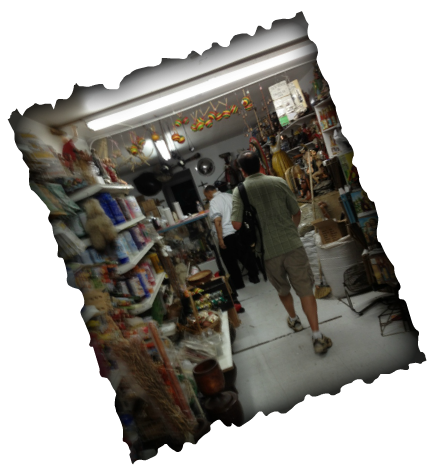  After lunch we proceeded through Central Park, had a class in the park then traveled onward to the MMoA (Museum of Modern Art). The MMoA is hosting PUNK: Chaos to Couture; a history of punk fashion from the 1970s and its influence on designers today. From this point I separated from the group and went to explore the Medieval Art Exhibit. 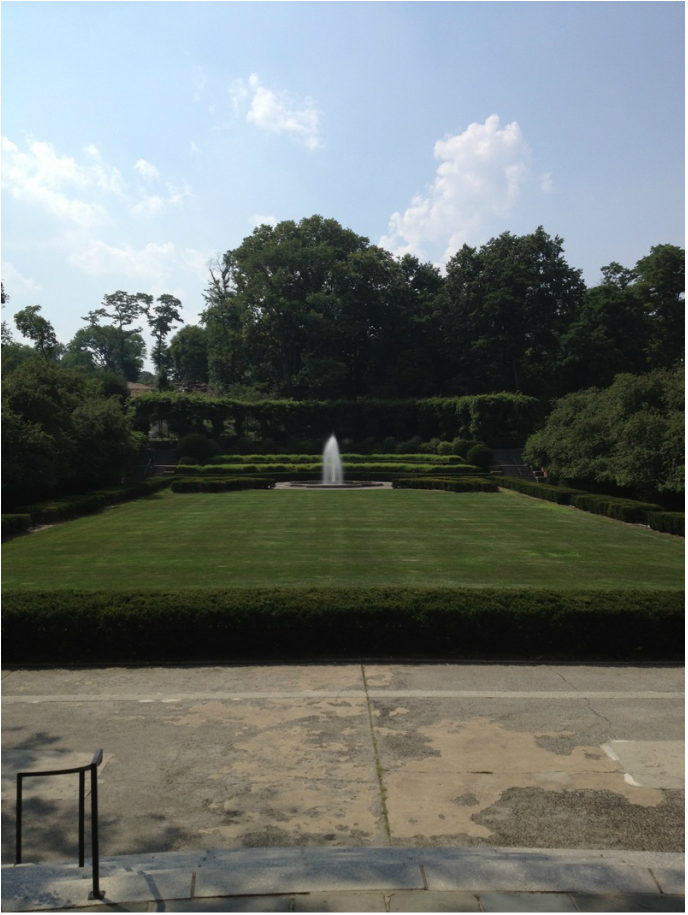  Two pieces caught my eye on this trip: The Ivory Rosary with Gilded-Silver Chain; The rosary’s inscription reads “Think on Death” and “This is What You Will Be”. The rosary was carved in Germany between 1500 and 1525: this piece explains that life and death are intimately connected. The image of half skull and half living person serve to remind one that life only lasts a short time and death is permanent so live a virtuous life so one may dwell in the house of the lord.  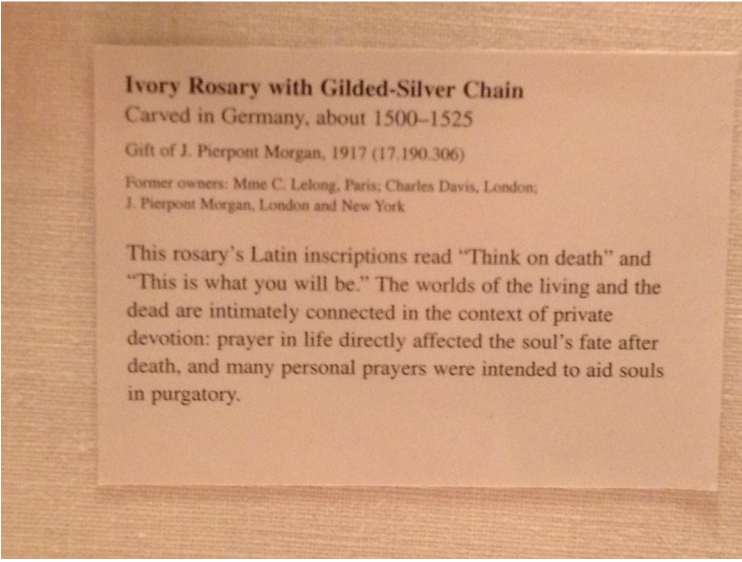 The second piece that caught my eye was the diptych “Boxwood Rosary Bead with Scenes From Christ’s Passion”. This interesting piece is of great mystery to me, it is very small and designed with intricate details of Christ’s Passion. A diptych is an object with two flat hinged plates attached. Next to the diptych is a triptych which is an art piece with three hinged panels. These are a gothic art created in Greece during the 1500s. Each micro-sculpted piece is carved in intricately detailed sections then placed in the shell piece by piece. In the diptych here Christ is seen on the cross dying, while chaos is ensuing around him. The Roman Soldiers are in the forefront, some riding their horses. In the triptych the scene is much of the same with both style and design. 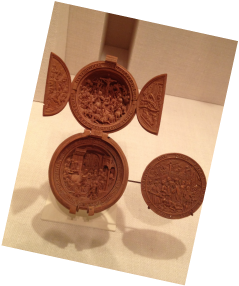 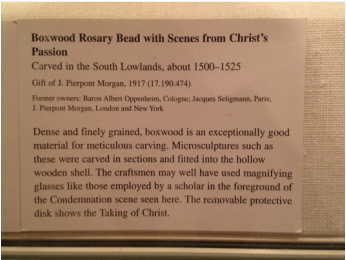 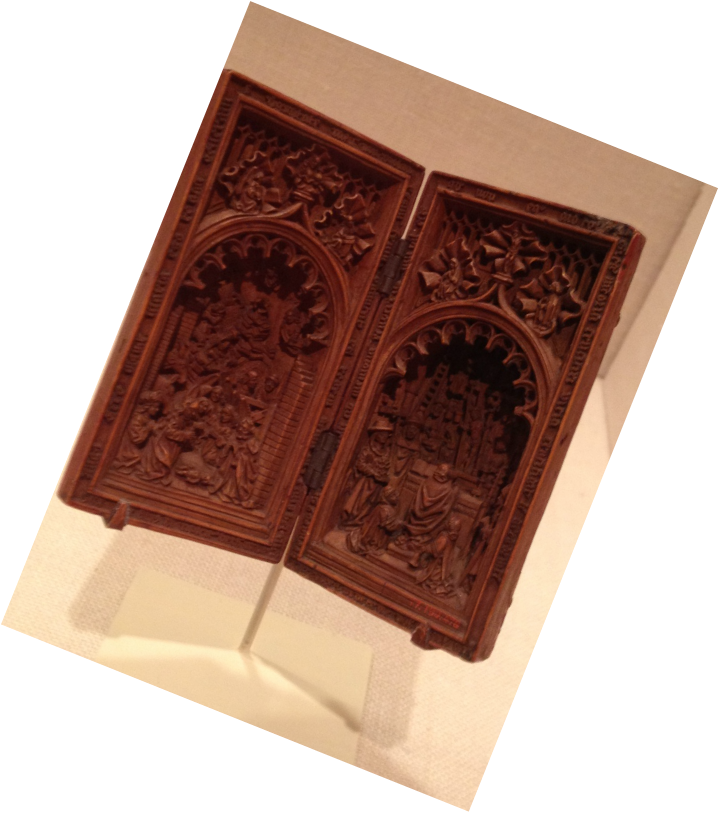 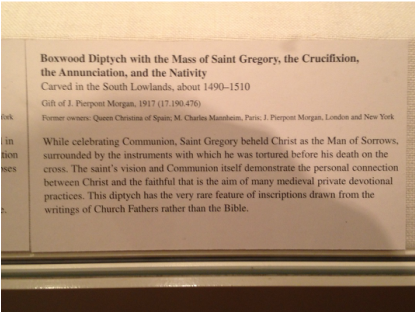 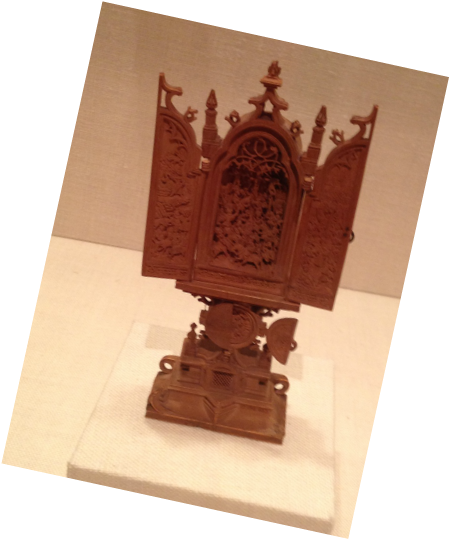 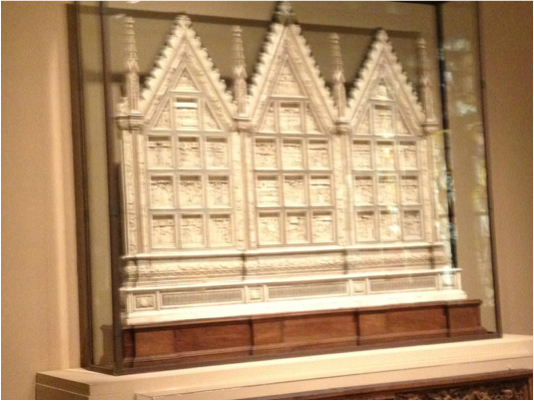
Wednesday, July 24, 2013 was a day to learn about the upper west side of Manhattan, one of the borough’s in New York City. The experience began in Pennsylvania Station at the information booth where the group gathers each session; exiting the station and walking up Broadway. The group stopped to discuss the city’s new Citi bikes and pedestrian zones. The New York City Department of Transportation (DOT) recognized the dangers of being a pedestrian, biker rider and driver in the borough. Pedestrians coming off the subway face numerous problems crossing the street to catch a bus putting their life on the line crossing and the vehicle drivers, when the unexpected pedestrian steps in the vehicles path the driver, attempting to avoid the person hits another vehicle or structure. The DOT has addressed pedestrian safety with redirecting vehicle traffic and creating pedestrian safe zones throughout the five boroughs. A map of the pedestrian safe zones is seen below. 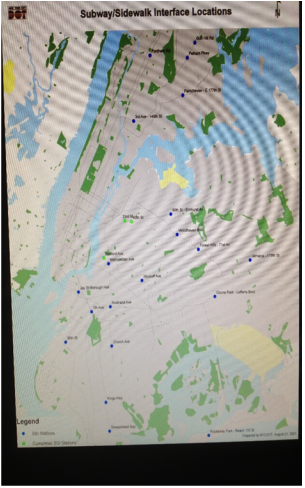 Pedestrian traffic throughout the city is immense but nowhere is it as thick as in mid-town Manhattan. To address this problem DOT built wider pedestrian walkways, bike paths and public gathering places between W. 35th and W. 42ND Streets (click hyperlink to view map of the area). In addition to gathering and greater walkway space for pedestrians the largest bicycle-sharing program was launched on May 28, 2013. Citigroup financed the project opening 300 stations and 6,000 bicycles with the intention of opening 300 more stations. Mayor Bloomberg effectively found a new public transportation system without using taxpayer dollars that is environmentally sustainable and increased a person’s physical activity; kudos to Mayor Bloomberg’s initiative for the people. The experience continued along Manhattan’s theatre district and we discussed the heavy crime in the 1970’s to now, this is the safest city in the world forty years later. In the 1970s and 1980s 42nd St. was a known area filled with crime so much so the police could not control it; prostitutes where everywhere, XXX movies, men would stand outside 0.25 cent peep shows attempting to lure in the customers. The question is should the old Times Square have been cleaned up or is it better the new Times Square should look like a wannabe Las Vegas? Many have argued the old Times Square should have been cleaned. On February 13, 1979, The Guardian Angels formed under the leadership of Curtis Sliwa. The group initially called the Magnificent 13 wore red berets, white t-shirts and red jackets, making them immediately recognizable. The Guardian Angels began in New York City’s Borough of Manhattan with the mission to protect the citizens of New York against predators when they cannot defend themselves. Today the Angels are in six countries including Japan, the goal is to bring violence prevention programs to schools and communities across America (guardianangels.org). The experience brought us through Rockefeller Center where it was learned that in 1933 artist Diego Fresco and left wing artist was appointed the position to paint the theme of “man’s new possibilities, from his new understanding of material things’ (Blue Guide p. 249) Diego instead painted an illustration of Lenin’s Tomb. Lenin’s Tomb was the grave site of the Soviet leader Joseph Stalin: Stalin was thought to be a great leader and man who saved his people: yet he led by intimidation and the murder of 20 million people. Joseph Stalin died in 1953 and his body was placed in an honorary spot next to the body of Vladimir Lenin. On October 31, 1961 Stalin’s body was removed from the tomb in a move known as De-Stalinization. Diego’s painting included Lenin, workers surrounding the tomb with red flags, rich people playing cards with sexually transmitted diseased cells above them (Blue Guide p249). According to the Blue Guide Diego was asked to change Stalin’s face to another’s, he refused and Rockefeller destroyed the mural. We walked past the ice rink below, the Statue of Atlas and Saint Patrick’s Cathedral which is located across from Atlas on 50th St. and 5th Ave. Our destination was MOMA, the Museum of Modern Art on 57th Street. According to the Blue Guide (p 260) in 1929 Aldrich Rockefeller, Lilly Bliss and Mary Sullivan founded a small museum on Fifth Avenue near Fifty-Seventh Street the first show was a huge success attracting over 47,000 visitors. MoMa eventually moved to its present location beginning as a Brown Stone. Recently MoMa underwent an $858 million dollar renovation. The developer Yoshio Taniguchi, completed the project in 2006; the project increased space for MoMA’s educational drive featuring an auditorium that seats up to 125 people, areas to study and train teachers. We viewed the work by Jackson Pollack and Rothko, both, abstract expressionists. An abstract expressionist is a style of art that cannot be seen and is not concrete it is about evoking mood. Jackson provokes anger and hostility in his work whereas Rothko blends his colors in organic shapes. Mike described this as freeing ourselves from outmoded antiquated thought and behavior. Abstract art brings attitudes and emotions to the surface. Jasper Johns and Roshenburg where partners whose paintings included found objects to paint over. This style of painting helped form POP art some famous POP art artists are Andy Warhol and Ruscha. Damian brought us to the “White Canvas’ and explained art should get us thinking, I agree, but a white canvas? I do not know about this. Contemporary Art was our next stop on the second floor, contemporary art is art that is created during our lifetime. Contemporary art begins around 1960-1970s probably because the term post-modernism popped up at this time. 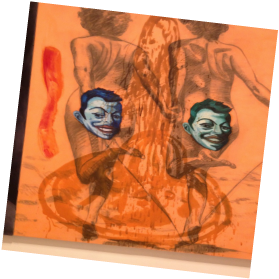 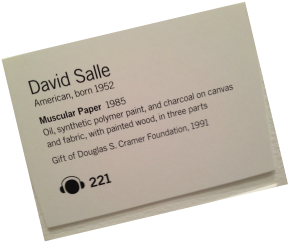 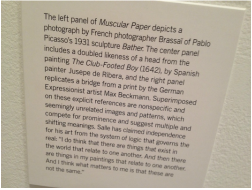 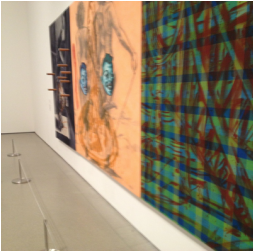 This Salle shown above has been created with oil, synthetic polymer paint and wood: in MoMA’s audio guide Salle describes each surface having a distinct texture and that the combination “creates intervals the eye has to confront and jump over”. As stated in the above description by MoMa, the panels portray works by other artists with some of Salle’s own work. Salle describes a lemon squeezer, left in a home he rented, was formed in a peculiar way; by enlarging it, caused it to lose all identity. Salle has found it to be quite comical that anyone could question the connection of the painting because “the painting is the connection”. In my subjective, non-artist mind I will have to view this painting again. The middle panel is the first panel the eye notices and quite seemingly for the few moments viewing the creation I did not notice a connection between the three, other than it came from the same artist copying others works. 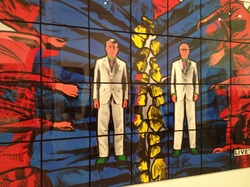 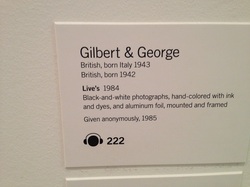 As shown above this creation by Gilbert and George, both British born artists took black and white photographs and adorned them with ink, dyes and aluminum foil. MoMAs audio teaches, that Gilbert and George who met at Saint Martin’s school of Art decided to “become the art work”. This piece Lives’ is constructed of twenty – eight photographs; creating a big negative picture “looking like stained glass”. Personally, upon my first interaction with the painting I thought of the Spiderman comic; the red and blue truly competes with the two figures Gilbert and George in the middle, I like the uniqueness of this particular style. 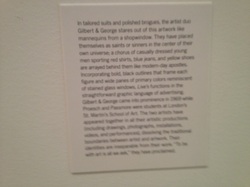 Upon leaving MoMa we detoured downtown to 42ndSt. And caught the subway to 135th and Lenox, where we met Jim, our tour guide and urban historian. Standing across from the Harlem Hospital, Jim was able to point out where Governor Patterson lives, Lenox Terrace the world’s largest brewery, and the Riverton Housing Project, this is subsidized housing overlooking the Harlem River. Lenox Avenue, Jim explained goes by two other names, the best way to remember them is to remember the “X” Malcolm X Leno X Avenue Si X Avenue 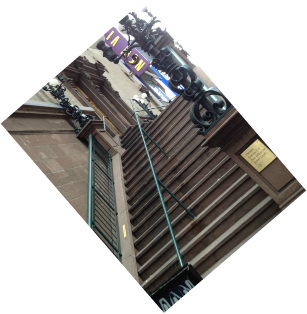 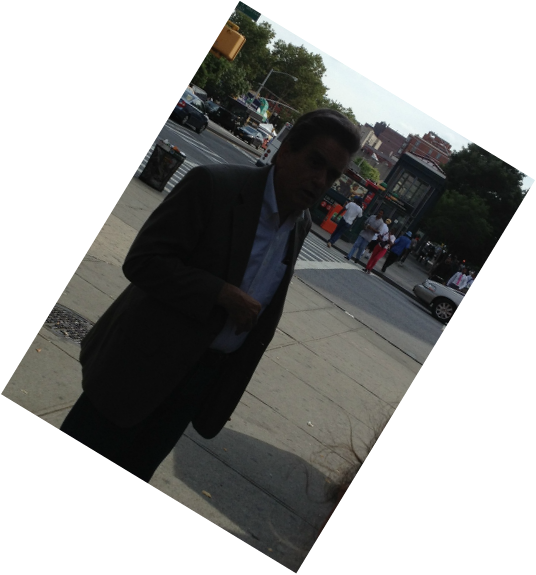 Jim, our tour guide Jim, our tour guide  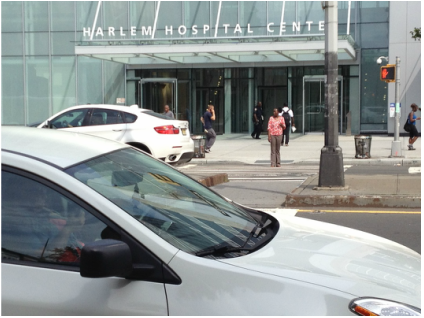  Windows of the hospital: people inside can see out, those outside cannot see in. Windows of the hospital: people inside can see out, those outside cannot see in. As it is in all of the five boroughs, Manhattan was settled by the Dutch with Harlem named in 1655/56 the Blue Guide states the Dutch named it Nieuw Haarlem the area is said to have been very beautiful attracting farmers and wealthy merchants. The Irish where brought in to work on the railways along with the Italians and Germans. The Jewish people flocked to the area: according to Jim the Jewish population reached 90,000 people. According to the blue Guide (p 437), in the late 1800s early 1900s it was speculated the white middle class would move to the area when this did not happen the market collapsed. In 1904 a black realtor named Philip Payton took over management and promised higher rents if blacks were allowed to move into the area. White business owners fought to keep Harlem white but according to the Blue Guide it was too profitable to rent to blacks thus, the African American population filled in the housing space and almost tripled in a twenty year time span. Harlem houses an interesting history: the landmarked area of Strivers Row, Apollo Theater, The Harlem Walk of Fame, and the infamous Cotton Club. Harlem is home to many famous people namely: Alicia Keys, Queen Latifa, Governor Patterson, Harry Belafonte, Orson Wells and Jack Johnson the first black fire fighter amongst others. President Clinton’s office space is in Harlem. Strivers Row, built by David C. King and two other builders Stanford White and Bill Washington in 1891. According to the Blue Guide (p.441) three developers were chosen, this was done to avoid repetition. There are four rows of homes located between Fredrick Douglas and Adam Clayton Powell Boulevards: The homes were initially known as the King Model Houses. The homes were built in speculation the white middle class would move in. In the 1920s realtors began to rent and sell the homes to black families; some of which were professionals and others who worked very hard to afford a middle class life style: King Model began to be called Strivers Row as we know it today. There is a discrepancy in our tour guides explanation of the brownstones color and the Blue guides: the Blue Guide states “On the south and north sides of 138th St are Bruce Prices Colonial Revival rows in yellow brick with terra cotta and limestone trim. James Brown Lord’s row on the south side of 138th St, has neo-Georgian red-brick houses with brownstone trim. Jim, our tour guide had suggested the brownstones were painted, he did not mention the three developers were chosen to avoid repetition nor the names of the rows. Harlem’s walk of fame reminds one of some of the famous great musicians of all-time: Bill “Bo jangles” Robinson, a tap dancer, choreographer, actor and singer, Dizzy Gillespie a composer, musician, leader and innovator, and Billy Holiday are some of those highlighted here on the sidewalk. The National Association for the Advancement of Colored People (NAACP) once located on 135th St just east of the Walk of Fame was building number 224, this is now home to Flo’s Beauty. There are three parks in the area, built here because building a street would prove too difficult: between 110th St and 122nd Streets, Morning Side Park was built in the 1880s. In the 1890s between 127th and 139th Streets, Saint Nicholas Park was constructed and in the same time period between 145th and 155th Streets Colonial Park, also known as Jackie Robinson Park was erected as well. Our day came to a close with racing up the steps of Morningside Park: it is guesstimated the stair total is one hundred fifty-five steps with an incline of straight up. Mike, an athletic man raced those students who wanted to race him up the stairs and was beaten by two. I was actually impressed by his spunk, he was able to give himself a head start, thus enabling these two students to gain track time ahead of him: kudos to all who made it up. We finished with a short tour of Saint John the Divine and Columbia University were Damian graduated. 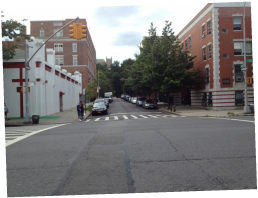  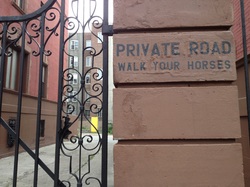 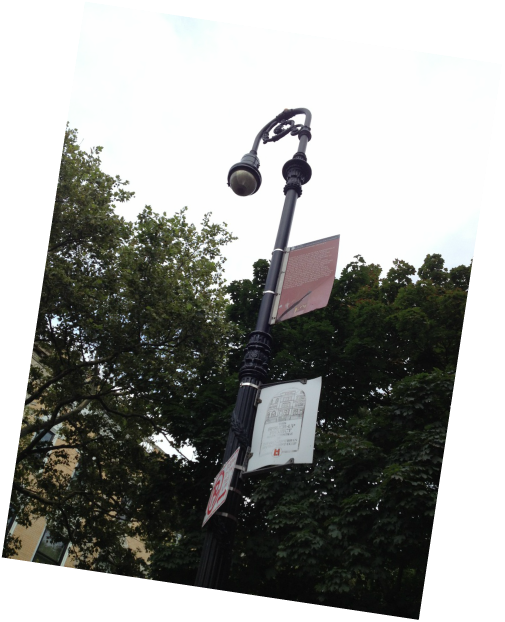 Harlem’s walk of fame reminds one of some of the famous great musicians of all-time: Bill “Bo jangles” Robinson, a tap dancer, choreographer, actor and singer, Dizzy Gillespie a composer, musician, leader and innovator, and Billy Holiday are some of those highlighted here on the sidewalk. The National Association for the Advancement of Colored People (NAACP) once located on 135th St just east of the Walk of Fame was building number 224, this is now home to Flo’s Beauty. \ There are three parks in the area, built here because building a street would prove too difficult: between 110th St and 122nd Streets, Morning Side Park was built in the 1880s. In the 1890s between 127th and 139th Streets, Saint Nicholas Park was constructed and in the same time period between 145th and 155th Streets Colonial Park, also known as Jackie Robinson Park was erected as well.
Our day came to a close with racing up the steps of Morningside Park: it is guesstimated the stair total is one hundred fifty-five steps with an incline of straight up. Mike, an athletic man raced those students who wanted to race him up the stairs and was beaten by two. I was actually impressed by his spunk, he was able to give himself a head start, thus enabling these two students to gain track time ahead of him: kudos to all who made it up. We finished with a short tour of Saint John the Divine and Columbia University were Damian graduated. |
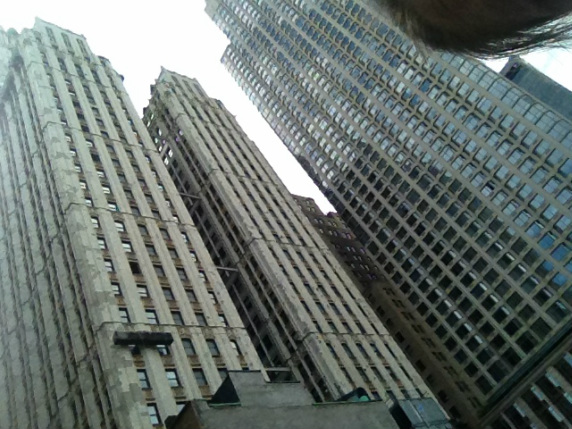
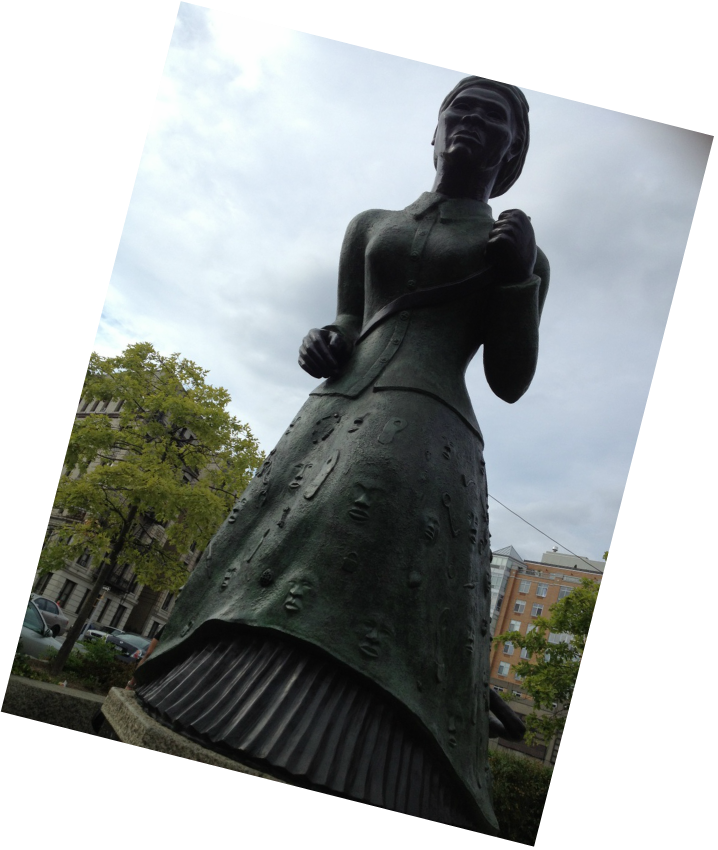

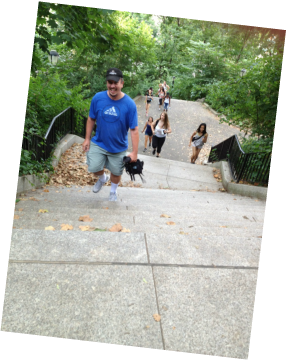
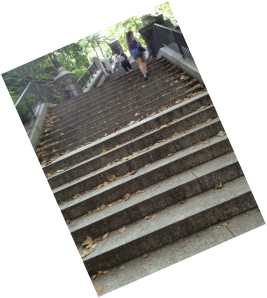
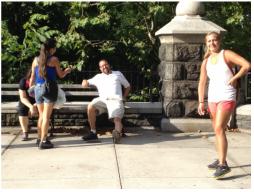
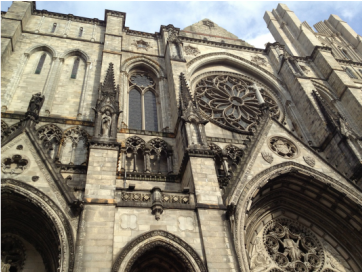
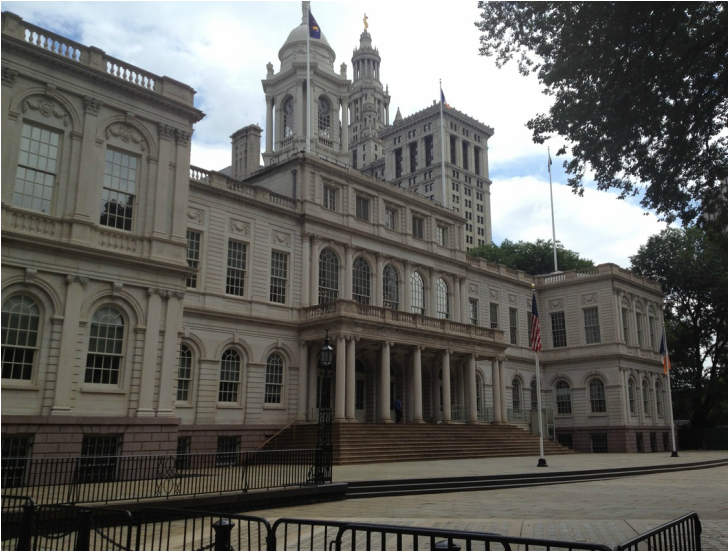
 RSS Feed
RSS Feed